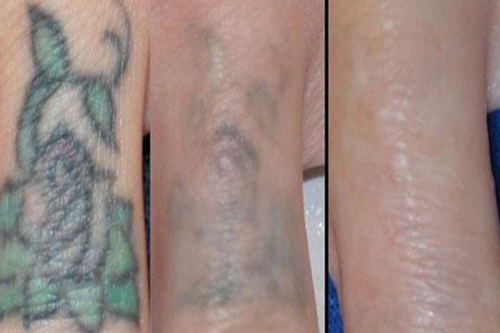
Tattoo Removal by Laser In Nagpur is a process designe to eliminate or fade the appearance of a tattoo from the skin. Various methods are use to break down the tattoo ink particles so that the body can naturally eliminate them. The effectiveness of tattoo removal depends on factors such as the size, color, and type of ink use in the tattoo, as well as the individual’s skin type.
Tattoo removal procedures are typically perform by dermatologists or traine specialists in medical aesthetics. It’s advisable to consult with a qualified professional to determine the most suitable method base on the specific tattoo and individual considerations.
Common Methods for tattoo removal
Laser Tattoo Removal:
- Laser technology is the most common method for tattoo removal. Different wavelengths of laser light are use to target specific colors of ink. The laser breaks down the ink particles into smaller fragments, allowing the body’s immune system to gradually remove them. Multiple sessions are usually required for optimal results.
Intense Pulse Light (IPL):
- Similar to laser treatment, IPL uses high-intensity light to target and break down tattoo pigments. It is particularly effective for removing red and brown pigments.
Chemical Peel:
- Chemical peels involve applying an acid solution to the tattooe skin, causing the top layers to peel off. This process can help fade the tattoo over time.
Dermabrasion:
- Dermabrasion involves mechanically removing the top layers of skin containing the tattoo. This method is less commonly used today due to potential scarring and changes in skin texture.
Surgical Excision:
- In this method, the tattoo skin is surgically cut out, and the remaining skin is stitched together. Surgical excision is typically reserve for small tattoos.
Cover-Up Tattoos:
- Another approach is to cover the existing tattoo with a new one. Skill tattoo artists can design a new tattoo that incorporates or conceals the old design.
Types of Lasers
Firstly, Different types of lasers are used for tattoo removal, each targeting specific ink colors. once, Common lasers include Q-switched lasers, such as Q-switched Nd:YAG and Q-switched alexandrite lasers.
Laser Tattoo Removal Works
Principle of Laser Tattoo Removal:
- Laser devices emit highly concentrate beams of light energy. Different wavelengths of light are use to target specific colors of tattoo ink. The energy from the laser is absorbe by the ink particles in the skin.
Ink Fragmentation:
- Thus, The absorbe energy causes the tattoo ink to fragment into smaller particles. Once, The body’s immune system can more easily process and eliminate these smaller ink particles.
Treatment Sessions:
- Thus, Laser tattoo removal is typically performed through a series of sessions. The number of sessions require depends on factors such as the size, color, and depth of the tattoo, as well as the type of laser use.
Healing Process:
- After each laser treatment, the treate area may experience redness, swelling, and a sensation similar to sunburn. Thus, Over the following weeks, the body’s natural healing processes work to remove the fragmente ink particles.
Professional Consultation:
- Before undergoing laser tattoo removal, individuals typically have a consultation with a trained professional, often a dermatologist or a laser specialist. Thus, The consultation helps determine the feasibility of removal based on factors like skin type, tattoo characteristics, and overall health.
Potential Side Effects:
- While laser tattoo removal is generally safe, potential side effects may include temporary changes in skin pigmentation, scarring, and the risk of infection. Adhering to post-treatment care instructions is crucial to minimize these risks.
Tattoo Fade and Removal:
- Thus, With each session, the tattoo gradually fades. Therefore, Complete removal may not be achievable in all cases, and some residual pigment may remain. Thus The effectiveness of removal varies based on factors like tattoo size, color, and the individual’s skin characteristics.
